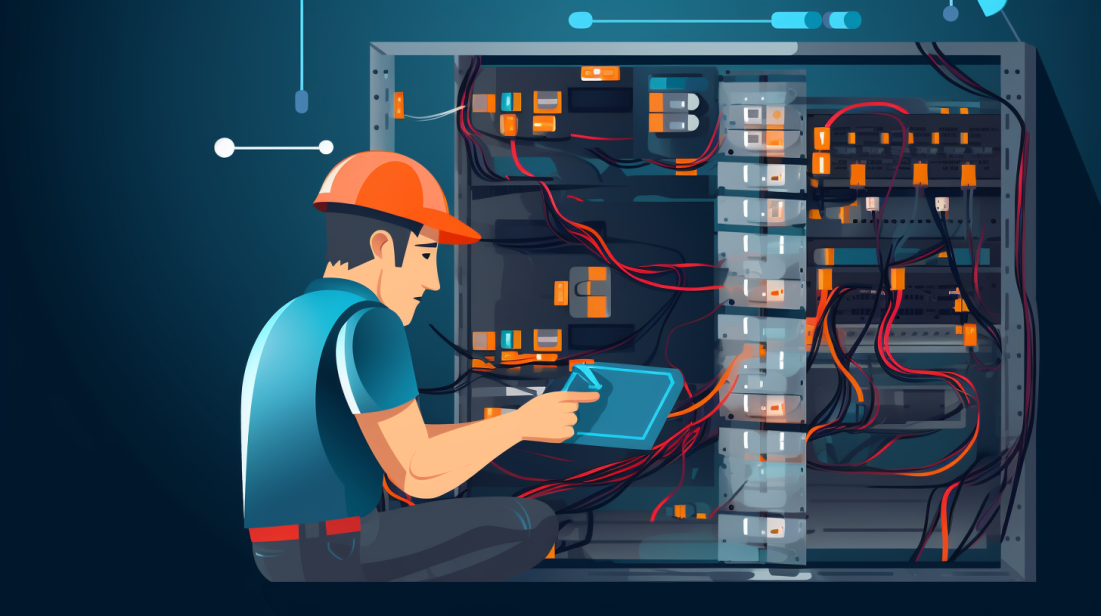Remote Work Internet Requirements

Ah, the familiar battle with a sluggish internet during our work from home routine, when infuriatingly on that all-important Zoom call (did you catch they need an upload and download speed of 600Kbps for one-on-one calls?), your screen decides it’s the perfect time to freeze.
Doesn’t that just make your day? Well, don’t sweat it, fellow home warrior! In this blog post let’s navigate through the complexities of internet speeds necessary for smooth telecommuting together.
Don’t click away – we’re about to roll out some nifty nuggets of advice to catapult your connection speed into warp drive!
Key Takeaways
- Good internet speed is needed for work from home tasks like video calls, emailing, streaming and sharing big files.
- There are ways to check and boost your internet speed. Use online test tools, move the router closer or think about getting faster service.
- The type of your Internet Provider matters a lot. Fiber providers like AT&T usually offer the highest speeds while mobile networks may be used if there’s no cable or fiber coverage in your area.
- Be mindful when choosing an Internet plan; it has to fit not only within budget limits but also meet heavy duty remote work needs such as large file transfers or frequently hosting video conferences.
Understanding Internet Speed
Internet speed matters a lot. It tells how fast your network can send or get data. We measure it in Mbps which means megabits per second. There are two types of internet speed – download and upload.
Download speed shows how quickly you can pull data from the server to you. When you watch movies or listen to music online, that is downloading. Upload speed tells us how fast you can send data from your device to others across the web like sending emails with big files attached or doing video calls on Zoom.
Having both high-speed downloads and uploads is good when working remotely. Fiber internet providers like AT&T, Google Fiber, and Verizon offer quick speeds for both uploading and downloading.
How to Check Your Internet Speed

I will show you easy steps to check your internet speed. Let’s dive in!
- Choose an online service for testing internet speed. Some good options are OOKLA SPEEDTEST and FAST.COM.
- Close any other apps or sites that are using the internet.
- Click on the “Go” button if you’re using OOKLA, or just wait as FAST.COM starts the test automatically.
- Be patient while the system checks both your download and upload speeds.
- Once done, note down your results for future reference.
What Internet Speed is Required for Different Remote Work Activities?
Ever wondered what internet speed is necessary for seamless video conferencing or instant large-file sharing? Get insights into the optimal internet speed different remote work activities demand and tips to improve yours.
Dive in, let’s untangle this web!
Video Conferencing (e.g., Zoom)
With tools like Zoom, video calls are easy. They let us talk to others when far away. But you need good internet speed for this. For a one-on-one call, the least speed needed is 600Kbps for both upload and download.
For a group call, the least download speed goes up to 800Kbps. Better quality calls need speeds of 1.5-2 Mbps for both upload and download.
Email and Chat Applications
For email and chat apps to work well, we need good internet speed. Some apps tell us the speed they need to work best. For example, Slack needs upload and download speeds of at least 600Kbps.
Google Hangouts and Google Meet also have their needs. They want an upload speed of 3.2Mbps and a download speed of 1.8Mbps for smooth talk and text chats. The number of users or devices might change this too! If more people are on at the same time, you may need more speed so everything still runs smoothly without lag or delay.
Web Browsing
Web browsing is a common work task. It’s important your internet speed keeps up. Slow pages can waste time and make you angry. For most websites, speeds of 1-5Mbps are good enough.
But faster sites might need more speed to load quick and right. Google Fiber, AT&T, Spectrum, and Verizon provide fast internet speeds for web browsing without delay or slow down times.
Streaming Media
To enjoy media streaming, you need good internet speed. Services like Netflix, Spotify and Zoom are all about this. They have movies for us to watch, songs for us to listen to and meetings for us to join.
Your internet connection can make a big change in how well these services work. You need an upload speed of 600Kbps and a download speed of 600Kbps as suggested by Zoom. This seems small but can be a lot if your network is slow or not strong enough.
Let’s look at some examples of faster providers from which I have enjoyed streaming services myself! Fiber internet providers such as AT&T and Google Fiber offer equal speeds for uploads and downloads so I never get annoying buffering issues when watching my favorite shows! Cable Internet Providers like Astound Broadband give high-speed downloads ranging up to 1,200Mbps!
Now you may ask yourself why both upload and download speeds matter in streaming? Simple answer: A movie needs steady downloading while chats during live events are uploads. My advice: always ensure your bandwidth meets these requirements before diving into the world of Skype group video calls or jamming out on Spotify!
Sharing Large Files

Sharing large files needs a strong internet speed. Fiber providers like Google Fiber, AT&T, and Verizon offer high speeds for this job. They give speeds from 100Mbps to 10,000Mbps.
Cable internet providers also offer good download speeds up to 1,200Mbps. Microsoft says an 8 Mbps download speed is needed for group video calls on Skype. This speed helps share big files too.
For Slack, the best download speed is 2Mbps which makes sharing large files faster and easier.
Factors Impacting Internet Speed
Ever wondered why sometimes your internet speed tanks even though you have a high-speed plan? Unstable networks, personal internet activity, the location of your router, and possible malware can all influence your connectivity.
Dive into our detailed guide to understand these factors and troubleshoot for an uninterrupted work from home experience.
Stability of the Network
A stable network is key for smooth remote work. This means your internet does not cut out or slow down a lot. You want the speed to stay the same most of the time. If it’s choppy, you could lose your work or drop calls.
A good router plays a big part in this. It sends strong signals all day long without any breaks. Having many devices on one network can make it unstable too, just like a traffic jam on a road.
Speed Fluctuations
The speed of the internet can change. This is called a ‘speed fluctuation‘. AT&T, Google Fiber and Verizon give fast upload and download speeds. These fiber internet providers help to limit these changes in speed.
Yet, Astound Broadband, Cox, and Spectrum are cable internet providers with different story. Their download speed swings from 100Mbps up to 1,200Mbps. This might cause your net speed to go up or down a lot.
Even when doing video calls on apps like Skype by Microsoft or Zoom can cause your net speed to switch around a bit too. When you use them for group video calls they need at least 8Mbps of download speed.
Router Location
I put my router in the middle of my house. It helps me get a good internet speed in every room. By being out in the open, my Wi-Fi signal does not fight with walls or other barriers to reach me.
So, if your home office is far from your router and you face slow speeds, try moving it closer. You can also use tools like a Wi-Fi Extender or Mesh System for better results.
Router Settings
I keep a close eye on my router settings. They have a big role in the speed of my internet when I work from home. A wrong setting can slow things down. But, it’s easy to fix if you know what to look for.
I make sure my router software is up-to-date first off that helps to work better. Also, choosing the right channel can clear up interference and boost speed.
Presence of Malware

Bad stuff like malware can slow down your internet speed. This is because it uses the network for bad things. You need good safety tools to find and stop this malware. Keep all devices safe from viruses and hackers.
This helps keep your internet fast for work from home.
Internet Throttling
Internet throttling is when your internet service provider (ISP) slows down your internet speed on purpose. ISPs do this for a few reasons. Sometimes, there are too many people online at the same time.
Also, there might not be enough bandwidth, which is the amount of data that can move through an ISP’s system.
I’ve found out that my own work gets hard when my ISP throttles my internet. If you’re having trouble with slow speeds, it could be because of throttling. Reach out to your ISP or think about getting a better plan if this keeps happening.
Personal Internet Activity
You might not know it, but what you do online can affect your internet speed. Let’s say you’re a fan of movies and music. If you stream lots of songs on Spotify or watch a bunch of films on Netflix while working from home, this could slow down your internet.
High-data tasks such as these use up more bandwidth than others. Your video calls may lag if too much bandwidth is used for fun stuff instead of work stuff! Same goes for playing online games during work hours.
So try to keep those movie marathons and gaming sessions off the clock to maintain fast speeds.
Tips to Improve Internet Speed for Remote Work
Working from home needs a fast internet speed. Here are some tips to help you:
- Use a wired connection instead of Wi – Fi.
- Put your router close to your work area.
- Try not to use many devices on the internet at once.
- Look for malware that could slow down your speed.
- Think about getting an internet upgrade.
- Find out if your provider is slowing down, or “throttling”, your speed.
- Keep your network safe with good security measures.
- Check if a Wi – Fi extender or mesh system can help reach far spots in your home.
- Be sure that you have set up the router right for fast speeds.
- Try using video calls less or lower their quality, as per need.
- Maybe switch to a fiber internet provider like AT&T, Google Fiber, or Verizon for faster download and upload speeds.
Selecting the Right Internet Provider for Remote Work

Picking a good internet provider is key for remote work. Each person working from home needs at least 10MBPS download speed and 1MBPS upload speed. Plus, you need a connection that won’t cut out during video calls or important tasks.
Fiber internet providers like AT&T, Google Fiber, and Verizon are good options. They often have the same fast speeds for both downloads and uploads. EarthLink is worth checking out too because it takes top marks in overall satisfaction, price, and customer service.
But fiber connections aren’t everywhere yet! If you can’t get one where you live now, don’t worry. You can try cable internet instead with providers like Spectrum which ranks best in general satisfaction among users.
Now what if cable also isn’t available to your place? Then mobile networks could be your go-to choice – they’re getting better by every day with more coverage even in rural areas thanks to technology leaps forward.
The last thing would be picking an Internet plan fitting both your work needs (like doing lots of video calls) as well as staying within budget limits you might want to set yourself for this part of home office setup costs.
Types of Internet Connections
Internet connections come in different types; each has its unique strengths and weaknesses. From the speedy fiber internet to dependable cable, mobile networks for on-the-go usage, and even everlasting dial-up.
Know your needs so you can choose which one’s right for your remote work setup. Fiber offers fast upload and download rates perfect for heavy data tasks while cable provides a strong connection ideal for day-to-day online activities.
Mobile Networks, such as 4G or 5G, offer flexibility but often face instability issues during peak times. Spend time identifying the pros and cons of each before deciding which fits best with your remote job requirements because it’s essential to have consistent fast Internet when working remotely!
Fiber
Fiber is a top pick for internet service. With fast speeds, often matching up and down rates, it’s great for work from home. You can get anywhere from 100Mbps to a crazy-fast 10,000Mbps with fiber! Earthlink tops the list for best fiber provider by people who use it.
Their price and customer care win high marks too. With fiber, we measure speed in Mbps or Gbps. So not only do you get lightning-fast speeds but also fewer hiccups during your Zoom calls or when sharing big files!
Cable

Cable is a fast choice for internet access. It uses the same lines that give us TV shows. Big companies like Spectrum offer cable internet to many homes. They give download speeds from 100Mbps to 1,200Mbps! This makes it great for big tasks or lots of users at once.
I did hear that Spectrum even won an award as the top pick for pleasing its customers with their service. However, one small downside could be during peak hours when many people are online at the same time and this can cause your speed to get slower because of “network congestion”.
Planning ahead helps so you can do large jobs outside of busy times and keep things running smoothly!
Mobile Networks
Mobile networks keep you online. Like your phone, they let you connect to the internet without a wire. Your device can talk with a tower that’s far away. This is how 3G, 4G, and 5G work! Mobile internet speed depends on where you are and how many people are using it at the same time.
Not all places have a strong signal. This means it might be slow or not work at all in some spots! But mobile networks are getting better fast now with new tech like 5G making it super quick.
Frequently Asked Questions (FAQs) about Internet Speed for Remote Work
Here are a few common questions about internet speed for remote work:
- How fast should my internet be for remote work?
- What is the best fiber internet provider for remote work?
- Which cable internet provider is the best?
- What speed do I need for group video calls on Skype?
- What is the required speed for Zoom calls?
- Can I improve my internet speed at home?
- Should I switch my internet provider if I have to work from home now?
- How can I check my internet speeds?
- What factors can affect my internet speed working remotely?
- What’s the role of an Internet Service Provider (ISP) in regards to my internet needs when working remotely?
Conclusion

In the end, having good internet is key for working from home. You need to check your speed and make changes if needed. So pick the right service, improve your wifi, and work calmly at home!
What Are the Best Countries for Remote Work Visas with Reliable Internet Connection?
Looking for the best countries for remote work? Look no further! These countries offer a perfect blend of remote work opportunities and reliable internet connections. Enjoy seamless video meetings, fast downloads, and uninterrupted productivity in these remote work havens. Work from paradisiacal destinations like Barbados, Bermuda, or Estonia, where you’ll find beautiful landscapes and top-notch infrastructure tailored for remote professionals.
FAQs
1. What are the key remote work internet requirements?
Fast and reliable Internet connection, high bandwidth, low latency, and using a speed test to verify your network’s range are all vital for remote work.
2. How can I solve my home network’s Internet connection issues?
Your modem may need adjusting or upgrading to your equipment if you’re dealing with frequent slowdowns or issues in Microsoft Teams or Facebook Messenger due to internet traffic.
3. Which Internet Service Providers (ISPs) should I use for working from home?
Choosing ISPs differs based on speed tiers offered that match your needs; popular ones include Xfinity and cable internet service among others like fiber-optic and 5G networks.
4. How do some digital nomads deal with their network connections?
Digital nomads often rely on multiple types of internet connection such as mobile 5G networks, Fiber optic connections, DSL or Satellite connections provided by many global cities as ranked in the Global Nomad Index
5. Is there an easy way to find out how much speed is enough for me when working remotely?
Yes! You can run an online ‘internet speed test’ which helps you understand what gaps exist within either MBPS/MB—or even gigabytes capacity—and thereafter refer to FCC’s recommendations according again to your specific demand such as large file transfers etc.,
6 If I am not happy with my present service provider’s reliability satisfaction rates who else could help?
You might consider Airbnb “Verified WiFi”, they provide guests assurance regarding the speeds before letting properties; thus making it ideal especially if you consistently travel whilst working.






